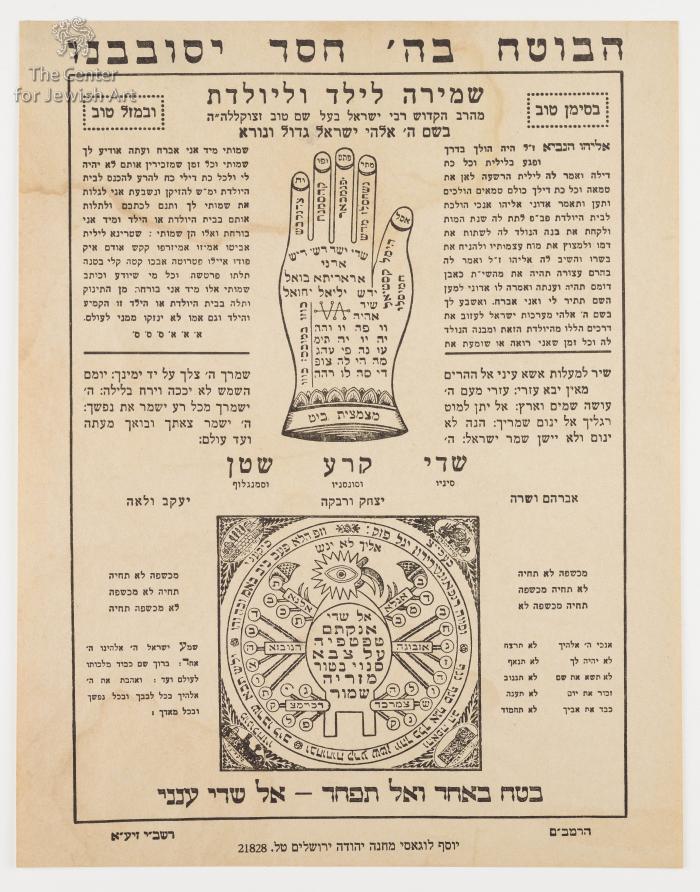Obj. ID: 53970 Shmirah le-Yeled ule-Yoledet, Jerusalem, circa 1960

sub-set tree:
O | Ornamentation: | Full page framed
A | Angel | Angel, multi-winged
J | Jerusalem | Sites in Jerusalem: | Western Wall (Kotel) הכותל המערבי
H | Holy and other places in the Land of Israel | Holy Tombs | Rachel's Tomb
J | Jerusalem | Zion, Holy City עיה'ק ציון
H | Holy and other places in the Land of Israel | Holy Tombs | Cave of Machpelah (Tomb of the Patriarchs/Matriarchs)
|
The following description was prepared by William Gross:
From earliest times, man has tried to protect himself from misfortune by the use of objects that he considered holy or otherwise (e.g., magically) potent. Amulets and talismans are Items generally worn around the neck or wrist, carried in a pocket or purse, or hung on a wall. They are meant to protect or aid those who carried or wore them. The Hebrew word for the amulet, kame‘a, has the root meaning "to bind". Jewish amulets are usually comprised of texts (either letters or graphic symbols) that are inscribed on some sort of material; some may also contain plant matter or precious stones. The texts of amulets usually include holy names that are believed to have the ability to affect reality, along with incantations summoning angels or other magical powers. For the most part, an amulet has a specific purpose: to ease childbirth, facilitate recovery from illness, improve one’s livelihood, and so on, but in the modern world many are also made for general protection.
Printed amulets that could serve the purpose of hand-written talismans began to appear in the late 17th century, continuing into the 18th and 19th centuries. The few surviving examples from this period are of European origin. But in the 19th century, they began to be published almost as soon as the printing press in North Africa and the Middle East. In Jerusalem, such amulets began to be printed within the first decade after a printing house opened in Jerusalem in 1841.
This example is a form that appeared in the 1890s from the presses of Zuckerman a Levi but soon became the traditional Jerusalem birth amulet. This is a late printing of that form even after the founding of the State of Israel in 1948. This birth amulet was printed by the firm of Joseph Lugassy. The amulet depicts the hamsa as a Kabbalistic hand as well as an angle. This is taken directly from the traditional Jerusalem amulet printed since the beginning of the 20th century. Several of the amuletic formulas are specifically for protection from Lilith. Included as well are the"Shir le-Ma'alot" (Psalm 121) prayer, the names of Patriarch couples, and the story of Eliyahu meeting Lilith. The text also mentions that the amulets is based on the tradition of the Ba'al Shem Tov.
The firm of Joseph Lugassy began as a bookstore in 1924. Many printed items were printed specifically for him, but it appears that he became a printer as well towards the end of the decade of the 1930s when he became one of the largest Jewish printers in Morocco. In 1948 the Lugassy family made Aliyah to Israel and established a bookstore in Jerusalem, an institution continuing to this day. In Israel, as well printed items have appeared with the Lugassy firm as publishers including this amulet.
Publisher: Yosef Lugassy


